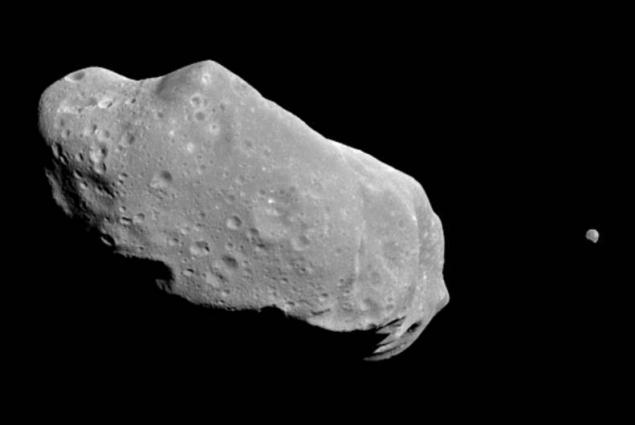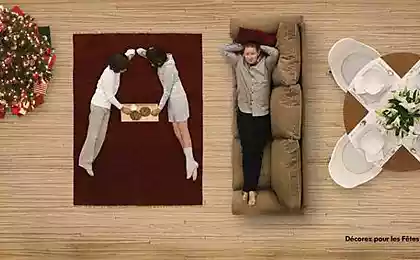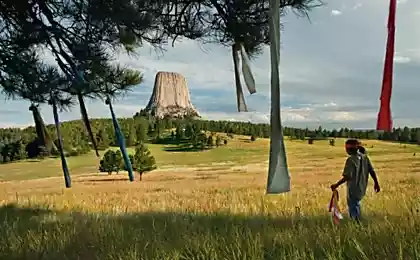212
Sky block called 2015 TB145 will fly by October 31 at a record close distance from Earth
The sky block called 2015 TB145 with a diameter of 620 meters will fly on October 31 at a record close distance from Earth - 499,000 kilometers, which is 1.3 distances from our planet to the moon.
For the layman, the situation is amazing - a considerable starstone flies to the Earth, and astronomers noticed it very late. Twenty days before the closest approach to our planet. It's good that the rock will fly by - consider it lucky. Could have been closer. Like that Chelyabinsk meteorite. It was only 17 meters in diameter and exploded, fortunately, in the atmosphere, but the blast wave covered the area 130 km long and 50 km wide. The windows in the houses were knocked out, people were offended. And here we are visiting a star body 40 times larger!
And we periodically discuss how we will knock down or deflect asteroids and other space bodies along the trajectory so that they do not destroy the planet.

Here is how the experts explain:
“If an asteroid with a diameter of 20 meters reaches the earth, an explosion wave will cover the territory equal to the Moscow region,” explains Lidia Rykhlova, Doctor of Physical and Mathematical Sciences, group leader at the Institute of Astronomy of the Russian Academy of Sciences.
- Wow! How did scientists actually miss the 2015 TB145 asteroid?
- Oh, - sighs Lydia Vasilievna. In 1948, the International Minor Planet Center was established. He moved from country to country several times and eventually settled in Cambridge, USA. It is funded by NASA grants. But in fact, this is a global structure - scientists from all over the world send the results of their research there. It's an awful lot. We can say that the asteroid belt is still poorly studied. And the study is quite chaotic - imagine how many of them all! Hundreds of thousands!
In 1998, several large telescopes were created in the United States, including 6-meter telescopes suitable for studying asteroids. At the same time, the United States began a ten-year program to study these celestial bodies with a diameter of more than one kilometer. Catalogues have been created. In 2008, this program ended and a new one began – asteroids more than 150 meters were studied.
Are our scientists not involved in this program?
We don’t have telescopes capable of doing this. Our institute has repeatedly appealed to the government and Roscosmos. The danger is real, and the Chelyabinsk meteorite showed it.
— Lydia Vasilievna, and still, why even advanced NASA astronomers noticed an asteroid, which in astronomical terms passes very close to our planet, so late?
It is a very fast flying weak object. Watching it is extremely difficult. And, you see, astronomers don't sit 24 hours a day all year round watching the entire starry sky. Look at one area, then another.
So the fact that the TB145 was spotted at all was just luck?
I think as we approached the Earth, he would have been noticed, which actually happened. Although, of course, it would be good to see such objects and lead sooner.
The last time such a rapprochement was 9 years ago, in 2006, when another asteroid flew at a distance of 1.1 distances from the Earth to the moon. The current asteroid is almost 40 times larger than Chelyabinsk and twice as fast as it, but the fall to Earth, fortunately, does not threaten. However, despite this, NASA experts, who discovered the celestial body about two weeks ago, still included it in the composition of potentially dangerous (they include all asteroids whose orbits pass 8 million kilometers from our planet and closer).
As explained by Sergei Naroenkov, an employee of the Institute of Astronomy of the Russian Academy of Sciences, on the night of October 30-31, the asteroid will be visible in the southeastern part of the sky at an azimuth of 130 degrees and 30 degrees above the horizon in the form of a small star, and that can be seen through a telescope. For observation, a device with a mirror diameter of 8 centimeters is suitable. During the night of 2015 TB145, the celestial body will follow to the southwestern part of the sky, passing from the constellation Taurus to the constellation Orion. From the moon it will pass 120 thousand kilometers.
P.S. And remember, just changing our consumption – together we change the world!
Join us on Facebook, VKontakte, Odnoklassniki
Source: masterok.livejournal.com/2584467.html
For the layman, the situation is amazing - a considerable starstone flies to the Earth, and astronomers noticed it very late. Twenty days before the closest approach to our planet. It's good that the rock will fly by - consider it lucky. Could have been closer. Like that Chelyabinsk meteorite. It was only 17 meters in diameter and exploded, fortunately, in the atmosphere, but the blast wave covered the area 130 km long and 50 km wide. The windows in the houses were knocked out, people were offended. And here we are visiting a star body 40 times larger!
And we periodically discuss how we will knock down or deflect asteroids and other space bodies along the trajectory so that they do not destroy the planet.

Here is how the experts explain:
“If an asteroid with a diameter of 20 meters reaches the earth, an explosion wave will cover the territory equal to the Moscow region,” explains Lidia Rykhlova, Doctor of Physical and Mathematical Sciences, group leader at the Institute of Astronomy of the Russian Academy of Sciences.
- Wow! How did scientists actually miss the 2015 TB145 asteroid?
- Oh, - sighs Lydia Vasilievna. In 1948, the International Minor Planet Center was established. He moved from country to country several times and eventually settled in Cambridge, USA. It is funded by NASA grants. But in fact, this is a global structure - scientists from all over the world send the results of their research there. It's an awful lot. We can say that the asteroid belt is still poorly studied. And the study is quite chaotic - imagine how many of them all! Hundreds of thousands!
In 1998, several large telescopes were created in the United States, including 6-meter telescopes suitable for studying asteroids. At the same time, the United States began a ten-year program to study these celestial bodies with a diameter of more than one kilometer. Catalogues have been created. In 2008, this program ended and a new one began – asteroids more than 150 meters were studied.
Are our scientists not involved in this program?
We don’t have telescopes capable of doing this. Our institute has repeatedly appealed to the government and Roscosmos. The danger is real, and the Chelyabinsk meteorite showed it.
— Lydia Vasilievna, and still, why even advanced NASA astronomers noticed an asteroid, which in astronomical terms passes very close to our planet, so late?
It is a very fast flying weak object. Watching it is extremely difficult. And, you see, astronomers don't sit 24 hours a day all year round watching the entire starry sky. Look at one area, then another.
So the fact that the TB145 was spotted at all was just luck?
I think as we approached the Earth, he would have been noticed, which actually happened. Although, of course, it would be good to see such objects and lead sooner.
The last time such a rapprochement was 9 years ago, in 2006, when another asteroid flew at a distance of 1.1 distances from the Earth to the moon. The current asteroid is almost 40 times larger than Chelyabinsk and twice as fast as it, but the fall to Earth, fortunately, does not threaten. However, despite this, NASA experts, who discovered the celestial body about two weeks ago, still included it in the composition of potentially dangerous (they include all asteroids whose orbits pass 8 million kilometers from our planet and closer).
As explained by Sergei Naroenkov, an employee of the Institute of Astronomy of the Russian Academy of Sciences, on the night of October 30-31, the asteroid will be visible in the southeastern part of the sky at an azimuth of 130 degrees and 30 degrees above the horizon in the form of a small star, and that can be seen through a telescope. For observation, a device with a mirror diameter of 8 centimeters is suitable. During the night of 2015 TB145, the celestial body will follow to the southwestern part of the sky, passing from the constellation Taurus to the constellation Orion. From the moon it will pass 120 thousand kilometers.
P.S. And remember, just changing our consumption – together we change the world!
Join us on Facebook, VKontakte, Odnoklassniki
Source: masterok.livejournal.com/2584467.html























